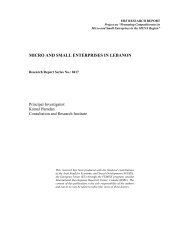local employment growth in the coastal area of tunisia - Economic ...
local employment growth in the coastal area of tunisia - Economic ...
local employment growth in the coastal area of tunisia - Economic ...
You also want an ePaper? Increase the reach of your titles
YUMPU automatically turns print PDFs into web optimized ePapers that Google loves.
total manufactur<strong>in</strong>g <strong>employment</strong> by sector, <strong>the</strong> number <strong>of</strong> firms hav<strong>in</strong>g at least 10 workers,<br />
<strong>in</strong>frastructure facilities (roads, quality <strong>of</strong> <strong>the</strong> <strong>in</strong>dustrial parks), human capital (share <strong>of</strong> high<br />
skilled workers) and <strong>the</strong> average delegation’s wage level.<br />
Figure 4 depicts distribution <strong>of</strong> manufactur<strong>in</strong>g <strong>employment</strong> and number <strong>of</strong> firms for six years.<br />
We can see that <strong>the</strong> <strong>employment</strong> rate by delegation slightly <strong>in</strong>creases between 2002-2007.<br />
However, its distribution is strongly unequal. We consider five manufactur<strong>in</strong>g <strong>in</strong>dustries:<br />
agro-food <strong>in</strong>dustry (IAA); pottery, glass and o<strong>the</strong>r non-metallic m<strong>in</strong>eral <strong>in</strong>dustry (IMCCV);<br />
mechanical, electrical and electronic <strong>in</strong>dustry (IME); chemical <strong>in</strong>dustry (ICH); and textiles,<br />
wear<strong>in</strong>g apparel, lea<strong>the</strong>r and footwear <strong>in</strong>dustry (ITHC).<br />
Table 5 <strong>in</strong> <strong>the</strong> appendix gives employees’ numbers and <strong>employment</strong> shares <strong>of</strong> each sector <strong>in</strong><br />
<strong>the</strong> <strong>coastal</strong> <strong>area</strong>, between 2002 and 2007. We can see that 50 per cent <strong>of</strong> all manufactur<strong>in</strong>g<br />
<strong>employment</strong> <strong>of</strong> <strong>the</strong> <strong>coastal</strong> <strong>area</strong>s is <strong>in</strong> ITHC. IMCCV and ICH sectors have <strong>the</strong> smallest share<br />
(about 5% <strong>of</strong> manufactur<strong>in</strong>g <strong>employment</strong>). IME and IAA have 17 % and 11 % <strong>of</strong> total <strong>coastal</strong><br />
manufactur<strong>in</strong>g jobs respectively.<br />
4.2 Spatial test, spatial filter<strong>in</strong>g and spillovers ranges<br />
Accord<strong>in</strong>g to <strong>the</strong> Moran’s test (Table 2), we reject <strong>the</strong> null hypo<strong>the</strong>sis <strong>of</strong> non-spatial<br />
autocorrelation, except for <strong>the</strong> two sectors: Glass and o<strong>the</strong>r non-metallic m<strong>in</strong>eral (IMCCV)<br />
from 2002 to 2004 and Chemical <strong>in</strong>dustry (ICH) from 2003 to 2007. This result confirms our<br />
hypo<strong>the</strong>sis <strong>of</strong> spatial externalities between each delegation and <strong>the</strong>ir neighbours.<br />
Ansel<strong>in</strong> et al. (1997) showed that spillovers have been found to be significantly effective only<br />
with<strong>in</strong> a range <strong>of</strong> 50 km. Our results (Table 2) show that IAA and IMCCV <strong>in</strong>dustries present<br />
<strong>the</strong> largest range <strong>of</strong> spillovers (44.54 km and 44.51 km respectively). Less range spillovers<br />
effects has been detected for <strong>the</strong> two sectors: mechanical, electrical and electronic (19.65 km)<br />
and chemical <strong>in</strong>dustry (22.39 km). These first results go <strong>in</strong> <strong>the</strong> same direction as those <strong>of</strong><br />
(Bad<strong>in</strong>ger et al., 2004; Duranton & Overman, 2005; Ansel<strong>in</strong> et al., 1997). Indeed,<br />
technological externalities for high technology <strong>in</strong>dustries (mechanical, electric or chemical<br />
<strong>in</strong>dustries) propagations are limited to <strong>the</strong> closest neighbours. However, for traditional<br />
<strong>in</strong>dustries (textile, agro-food and construction), <strong>the</strong>se technological externalities can affect<br />
more distant <strong>area</strong>s <strong>in</strong> Tunisia.<br />
4.3 Econometric results<br />
Table 3 depicts <strong>the</strong> GMM (GMM-SYS) estimation results <strong>of</strong> <strong>the</strong> dynamic model for five<br />
different sectors, us<strong>in</strong>g <strong>the</strong> spatially filtered variables. But table 4 give us results <strong>of</strong> some<br />
validation tests.<br />
Model Validation<br />
Statistical test <strong>of</strong> serial correlation (,AR(1) and AR(2) Arellano-Bond test (Arellano & Bond<br />
1991) 7 ) and over-identification Sargan test, (Sargan (1958)) are presented <strong>in</strong> Table 4.<br />
Statistical tests regard<strong>in</strong>g serial correlation (AR(1) and AR(2)) reject <strong>the</strong> absence <strong>of</strong> first<br />
order serial correlation for (IAA), (ICH) and (ITH) at 5%, but not second order serial<br />
correlation. The Sargan tests do not reject <strong>the</strong> overidentify<strong>in</strong>g restrictions.<br />
Specialization<br />
Results <strong>of</strong> Table 3 show that all <strong>the</strong> parameters on <strong>the</strong> lagged dependent variables are less<br />
than one, we can’t reject <strong>the</strong> specialization hypo<strong>the</strong>sis. 8 This result is not surpris<strong>in</strong>g. Thus,<br />
Henderson (2003) shows that <strong>in</strong> <strong>the</strong> short term <strong>of</strong> cluster development specialized clusters<br />
7 AR(1) and AR(2) test, respectively, <strong>the</strong> first and <strong>the</strong> second-order autocorrelation <strong>in</strong> <strong>the</strong> first differenced<br />
residuals.<br />
8 An <strong>in</strong>dustry is regarded as specialized if <strong>the</strong> parameter on <strong>the</strong> lagged dependent variable is greater than 1<br />
(Blien et al., 2006).<br />
10

















